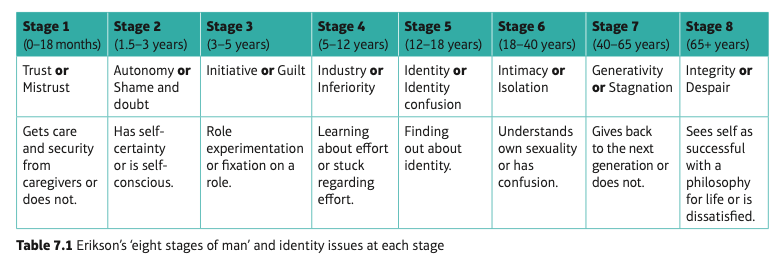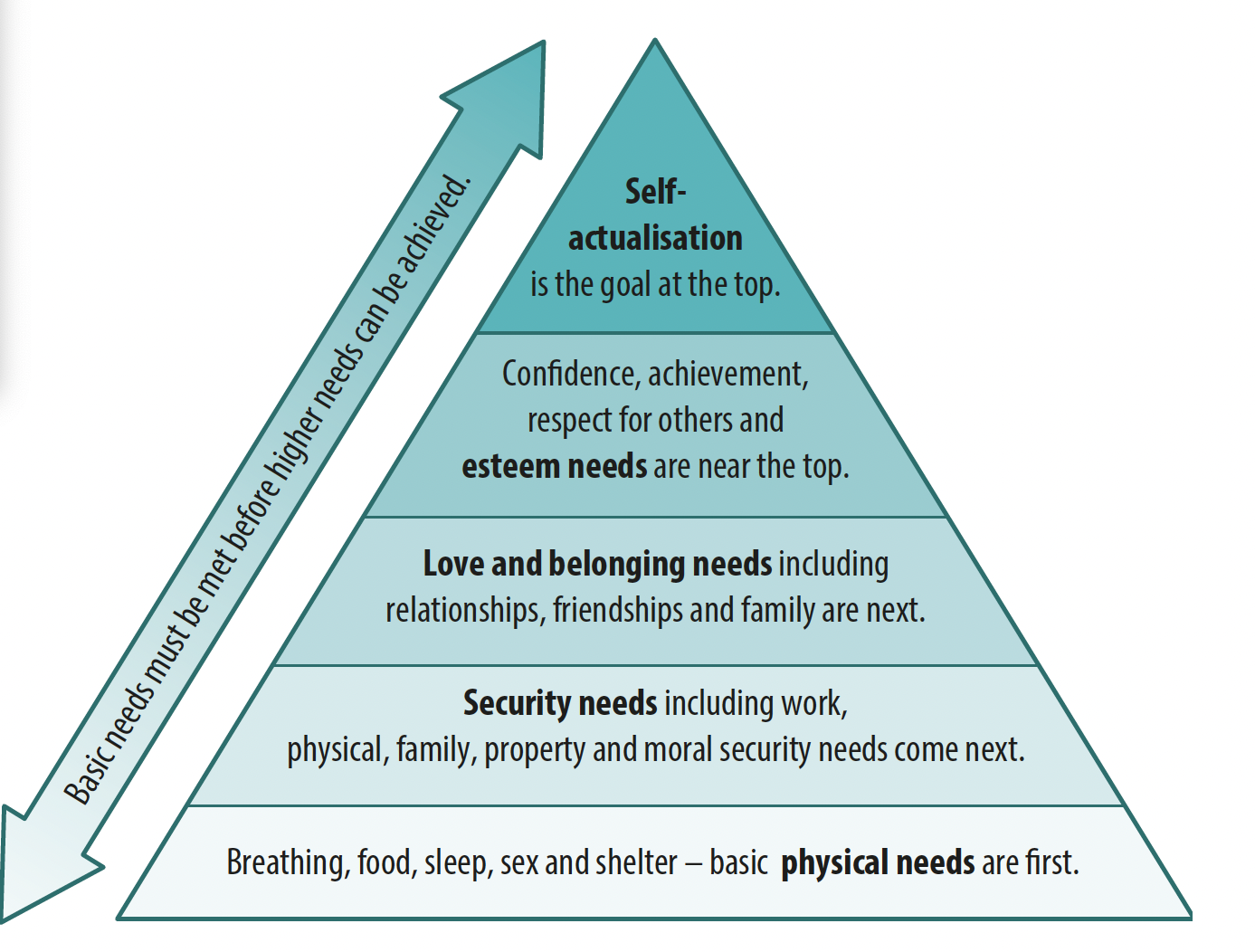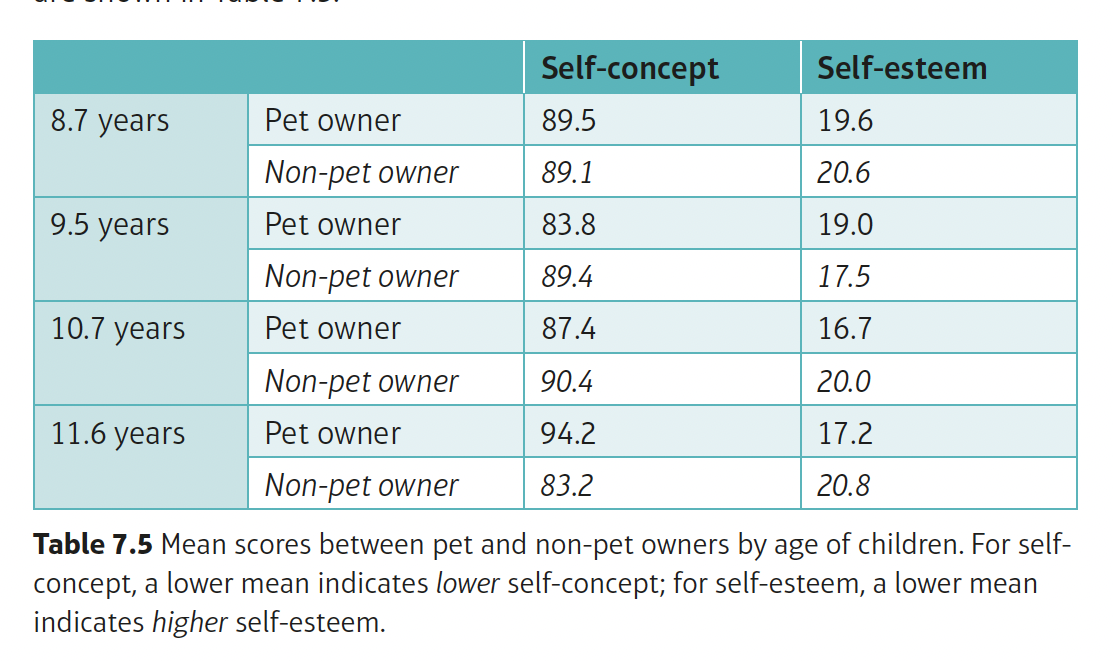topic 7 - the self
1/63
Earn XP
Name | Mastery | Learn | Test | Matching | Spaced |
|---|
No study sessions yet.
64 Terms
self-concept
how we see ourselves based on how others see us and our own beliefs
Michael Lewis’s (1990) explanation of the self and self-concept
he split the self into two parts:
the existential self
the categorical self
existential self
awareness that we have an existence that is separate from others
categorical self
awareness that we are seen by others by means of categories, such as age
evidence supporting Lewis’s concept of self and self-concept
Lewis and Jeanne Brooks-Gun (1979)’s red nose test
it found that children under the age of 18 months would reach for the nose in the mirror
it found that children above the age of 18 months would reach for their own nose instead of the one in the mirror
Carl Rogers’s (1959) explanation of the self and self-concept
he split self-concept into three parts:
self-image
self-esteem
ideal self
self-image
how we see ourselves
self-esteem
how we value ourselves
ideal self
how we would like to be
congruence
when self-image and ideal self match
incongruence
when self-image and ideal self don’t match
self-actualisation
when someone achieves their full potential in life
Erik Erikson’s (1959) theory of the role of identity in self development
his theory is known as the ‘eight stages of man’
it states that we develop through eight challenges or opportunities, each of which occurs at a particular age
the individual needs to resolve each crisis to successfully complete a stage

strengths of Erikson’s (1959) theory
it has practical applications and can be applied to people throughout their life (a lifespan theory)
Goodcase and Love (2016) suggest using Erikson’s ideas that older people are still developing and can benefit from examining their own beliefs
weaknesses of Erikson’s (1959) theory
cultures have wide differences in the age that a specific developmental stage might occur
Gilligan (1982) criticised this theory for using gender stereotyping, such as intimacy and isolation being about women more than men
free will
the ability to choose exactly what kind of behaviour we want to show (opposite of determinism)
determinism
belief that our actions come from what we are born with and what we experience (opposite of free will)
Roy Baumeister’s (2008) theory of the role of free will in self development
he states that self-control and making choices is ‘biologically expensive’ because it can deplete our sources by using up a lot of glucose in the brain
consequences of belief in free will
our justice system - if nobody is responsible for their behaviour, then punishment will not prevent a repeat of that behaviour
improves prosocial behaviour - people feel more empowered and in control of their actions and emotions and are more likely to help others
improves a person’s control over their emotions and impulses - it takes energy to make choices so being less impulsive saves up that energy
helps someone learn from the challenges they encounter - people are more likely to reflect on negative feeling associated with event and this can help them avoid similar events in the future
strengths of Baumeister’s (2008) views
focuses on our everyday understanding of what it means to act from free will and is therefore, a more useful approach
scientific experiments can be carried out to advance understanding of free will and decision-making (eg. Vohs and Schooler)
weaknesses of Baumeister’s (2008) views
reducing free will to specific measurable behaviours (reductionism) can be said to not take the ‘whole’ of a person’s decision-making into account (holism)
Ebert and Wegner (2011) found that actions that are randomly displayed can be mistaken as coming from free will
Carl Rogers’ (1951) humanistic theory of the self and self-esteem
humans are good by nature
all individuals naturally aim for personal growth in order to reach self-actualisation
to become the best we can be, we must have a positive sense of self-concept and be in a state of congruence
childhood is an important time in our development
self-esteem reflects our idea of self-worth
he aimed to help individuals raise their self-worth and self-esteem to achieve a state of congruence and move towards self-actualisation
conditional positive regard
being valued but only according to certain conditions, which can lower a person’s overall self-esteem
unconditional positive regard
being valued for who you are regardless of any conditions, which can improve a person’s overall self-esteem
conditions of worth
conditions people feel that they must meet in order to be worthy of being loved
strengths of Carl Rogers’ (1951) humanistic theory of the self and self-esteem
it is a form of positive psychology
focuses on improving a person’s mental health which can save society’s health costs and build a stronger work force
it has a wide application in therapy (CBT)
weaknesses of Carl Rogers’ (1951) humanistic theory of the self and self-esteem
it is hard to measure which makes it less scientific
it does not suit all medical conditions as Eyessen et al. (2013) found that client-centred therapy did not help those with multiple sclerosis compared with occupational therapy
Abraham Maslow’s (1943) Hierarchy of Needs diagram

strengths of Abraham Maslow’s (1943) Hierarchy of Needs
it is a form of positive psychology
weaknesses of Abraham Maslow’s (1943) Hierarchy of Needs
tends to focus more on Western culture
the concepts cannot be measured so it cannot be tested scientifically to show universality
claims that humans are inherently good but this needs evidence
Ijzendoorn et al. (2010) found that 7-year-old children did not show moral behaviour because of inborn temperament
what is the internal influence on the self and self-esteem?
temperament
temperament
a biological aspect of a person that relates to emotions and controlling oneself which affects their behaviour
aspects of temperament
effortful control
negative emotions
persistence
effortful control
an aspect of temperament that refers to self-regulation and using reasoned effort to control actions and thoughts
Richard Robins et al. (2010) found that young adolescents who had a high self-esteem also had high levels of effortful control
negative emotions
Robins et al. (2010) found that another aspect of temperament is a tendency to have negative feelings, giving a person low self-esteem
persistence
an aspect of temperament is how task-oriented a person is
Windle et al. (1986) found that persistence goes hand-in-hand with high self-esteem
what is the external influence on the self and self-esteem?
experiences
what are aspects of experience as an external influence on the self and self-esteem?
self-efficacy
factors affecting self-image
perceptions of others
self-efficacy
how strongly we believe we can succeed in a certain situation or achieve a task
factors affecting self-image
Michael Argyle (2008) found that an important influence on our self-esteem is the reaction of others
a positive self-image comes from praise and attention
a negative self-image comes from criticism
perceptions of others
how the propel perceive us can change, which affects our self-esteem
Rina Bajaj (2008) discussed the effects of the London bombings in 2005 and found that the young men had the same internal beliefs as before but the way others perceived them had changed
how can personality be measured?
personality scales
personality types
personality scales
scales can measure someone’s personality using a particular trait
involves classifying information using numbers that represent certain characteristics
focuses on the Big Five (OCEAN): openness, conscientiousness, extraversion, agreeableness and neuroticism
personality types
a theory of personality can be a type theory or a trait theory
type theory
suggests that a person’s personality can fit into a category or type
trait theory
suggests that personalities have characteristics that are on a continuum
covers wider aspects of behaviour
what are the two trait theories?
Gordon Allport (1936) cardinal, central and secondary personality traits
Raymond Cattle (1946) 16PF personality factor assessment
Gordon Allport (1936)
he classified traits into three levels:
cardinal traits - rare traits that govern us very strongly, tending to dominate someone’s life
central traits - traits that are less strong and more common
secondary traits - traits we do not always show but still have
he identified around 4,000 traits that characterise each personality
Raymond Cattle (1946)
aimed to reduce Allport’s list of traits to something that would be easier to use to measure personality
he ended up reducing it to 171 traits
then he suggested that someone’s personality could be measured by how far they display certain traits
to measure personality, he looked at:
life data about a person’s everyday behaviour
data that assessed people’s reactions in certain situations
data to get people’s self-ratings about their behaviour and feelings
then, he used factor analysis on this data which reduced his list to 16 dimensions
strengths of trait theory as a measure of personality
Allport chose traits that were observable
the use of self-reporting scales left no interpretation from anyone else and this added to the validity of the findings
weaknesses of trait theory as a measure of personality
it is hard to predict someone’s behaviour because they may behave differently in different situations
people need to be self-aware in order to give self-ratings to represent their characteristics
does not explain why we have those characteristics which limits the theory
aim of Vohs and Schooler’s (2008) study
to see if encouraging a belief in determinism would encourage cheating
procedure of Vohs and Schooler’s (2008) study
13 female and 17 male university students were tested individually and were randomly allocated to the control or experimental group
experimental group read Francis Crick’s ‘anti-free will’ book and the control group read a book about consciousness but not about the issue of free will
participants were then put in a position that would allow them to cheat by using a computer program to give answers to maths problems they were supposed to solve themselves
to measure cheating, the number of presses on the space bar of a computer were recorded because it avoided the answer being revealed
dependent variable was the number of presses on the space bar and the independent variable was the passage that was read
results of Vohs and Schooler’s (2008) study
the experimental group showed lower belief in free will than those own the control group
participants showed more cheating if they read the anti-free will passage than if they did not
the higher the cheating score, the lower the free will and determinism score (negative correlation)

conclusions of Vohs and Schooler’s (2008) study
when determinism is put forward and free will is challenged, behaviour becomes less moral
weakening someone’s belief in free will increases the likelihood of cheating
Fred Schab (1991) found that self-reports of cheating have increased over time
strengths of Vohs and Schooler’s (2008) study
ethical strengths because they protected the anonymity of the participants and debriefed them after the experiment
practical application of the idea that behaviour comes from our genes and the environment
weaknesses of Vohs and Schooler’s (2008) study
it was thought that pressing the space bar meant not cheating but it could simply mean nothing
the moral behaviour that was measured was mildly unethical
the experiment was artificial, causing it to lack validity
aims of Van Houtte and Jarvis’s (1995) study
to find out how pets affect children's development
how having pets or not having pets affects affected children’s self-esteem, self-concept, sense of autonomy and attachment to animals
procedure of Van Houtte and Jarvis’s (1995) study
130 children aged between 8 and 11 years old were used
of the 130 children, 65 were pet owners and 65 were not pet owners
participants were informed of their rights before the study
interviews were conducted to gather background information about the child, their family, etc.
the pet-owning children were match to the non-pet owning children based in this information
independent variables was whether the child owned a pet or not
dependent variable was the autonomy, self-concept, self-esteem and attachment to animals that was all measured by questionnaires
what were the four measures taken in Van Houtte and Jarvis’s (1995) study?
measure of autonomy - the child’s perception of their parents
measure of self-concept - to find out the children's views of themselves
measure of self-esteem - how much the child agreed with the statements that they were asked about things regarding their self-esteem
measure of attachment to animals - a questionnaire was given to the pet-owning children to measure this
results of Van Houtte and Jarvis’s (1995) study
self-concept - 11-year-old pet owners had higher self-concept than non-pet owners of the same age
self-esteem – 9-year-old pet owners had lower self-esteem than 11-year-old pet owners; 10 and 11-year-old pet owners had noticeably higher self-esteem than non-pet owners
attachment to animals – the results for pet owners and non-pet owners were very similar so attachment to animals was taken as not relating to owning a pet
autonomy – pet owners were more likely than non-pet owners to see their parents as people and pet owners could see their parents in roles other than the parental role (both suggest autonomy)

conclusions of Van Houtte and Jarvis’s (1995) study
some support for the idea that pet owners showed higher autonomy, but it only focused on the aspect of how parents were perceived, not on all measures of autonomy
attachment to pets does not seem to relate to whether a pet is owned or not
pet ownership had the most positive impact on development just before the move into adolescence
strengths of Van Houtte and Jarvis’s (1995) study
results can be applied to real life
Judith Siegel (1990) found that pet support for the elderly helped to reduce stress
there was control over possible extraneous variables
weaknesses of Van Houtte and Jarvis’s (1995) study
children classified as non-pet owners may have had a pet that wasn’t a cat or a dog
used a specific age range of children in one school which could make generalising the results difficult